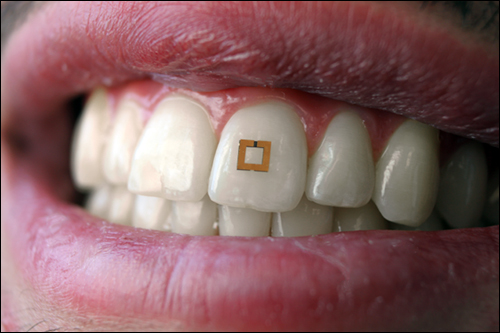Researchers at Tufts University’s School of Engineering have developed an RF system that captures sensor data and transmits it to a reader from a unique environment: a person’s mouth. The passive RFID tag is designed to be attached to a tooth, with a layer of built-in sensors that respond to such conditions as the presence of sugar or sodium, as a person enjoys a meal or snack. Tag transmissions are sent via 400 MHz RFID to an interrogator, and are then modified according to those conditions. The technology can identify not only the intake of specific nutrients or chemicals, the team reports, but also the body’s response to that intake, based on changes to a person’s saliva.
Fiorenzo Omenetto, the dean of research at Tufts’ School of Engineering, has led the efforts to develop a system that can automate the capture and collection of nutritional data while a person eats. The researchers speculate that this solution could have commercial benefits for health-care providers or those who wish to manage their diet based on health limitations. Tufts’ engineering department has already been working on implantable electronics, he says, that could provide a health-care benefit while being unobtrusive. According to Omenetto, the RFID-enabled sensor tag is the latest prototype to result from those efforts.
Existing technology has offered a few options for tracking dietary intake, Omenetto explains, but they have been difficult to use. Systems include a mouth guard that can be inserted in the mouth, but that would be uncomfortable to use all day. There are also wired solutions, but they similarly could only be used when plugged in. Not only is such technology bulky to wear, he notes, but it requires efforts on the part of a user to insert it into his or her mouth.
In recent years, the team had tested the use of off-the-shelf high-frequency (HF) 13.56 MHz RFID tags that could be attached to the skin, but now they were looking for something that would work inside the mouth, where food contents could be analyzed. Traditional RFID tags with sensors, Omenetto explains, would be too bulky for comfortable use by individuals. The 2-millimeter-square tag can be attached to a person’s tooth via an adhesive and responds to a specialized 400 MHz reader built at the Tufts lab.
Tufts’ new sensor tag consists of three layers. The central layer is made of either a porous, silk film or hydrogel interlayer, either of which the researchers refer to as a bio- responsive layer. Whether silk or hydrogel, the layer absorbs saliva nutrients and swells based on such changes as the presence of pH or temperature fluctuations. The two outer layers serve as wireless transmission technology, each an RF antenna in the form of a square golf ring around the tag’s exterior. If the central sensor layer swells, based on the presence of a specific nutrient such as glucose, the two antennas are slightly separated and the amplitude of response and resonant frequency is changed.
The interrogator would detect that modification, and software could identify what nutrient or chemical was present, and how much. In the future, Omenetto says, tags could be designed with a wide variety of sensor layers to identify a range of chemicals or nutrients, or an individual’s own physiological state.
According to Omenetto, the aim is to provide a system that health-care providers or consumers could use to better understand an individual’s intake of nutrients. For instance, if a patient were diabetic, then by attaching the RFID tag to a tooth and then using a specialized reader, he or she could identify how much glucose was being ingested at any given time, or throughout a day. The tag could also be used for those with eating disorders or dietary restrictions. They would, however, need to hold the interrogator within about a centimeter of the tag in order to ensure a reliable read, Omenetto notes.
The system represents a step toward more low-cost, small form-factor, sensor-based RFID tags, Omenetto says. “The exciting thing is that by changing the interlayer, you’re making a biologically enabled RFID tag,” he states. The researchers intend to continue engineering the tag and reader to not only include a wide variety of sensors, but accomplish a longer read range. “There’s still room for improvement for fabrication.”


